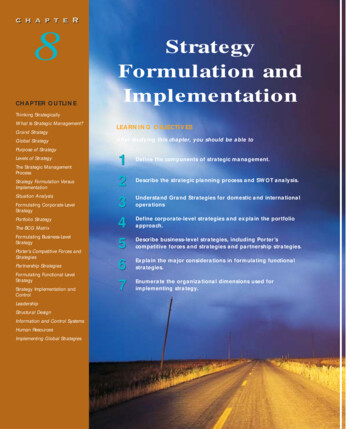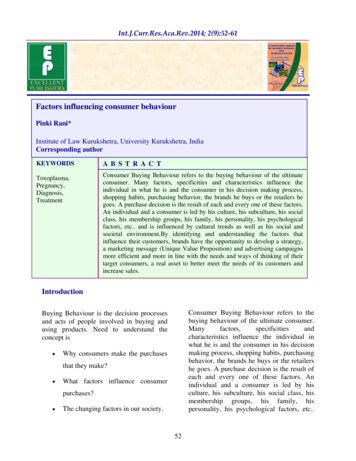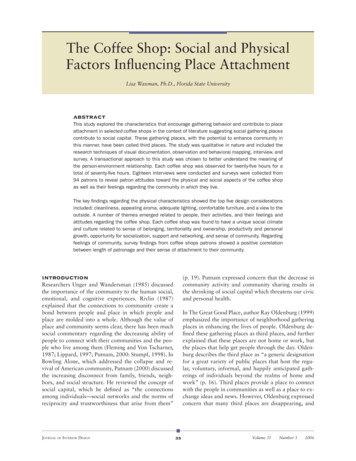
Transcription
International Journal of Business and Social ScienceVol. 8, No. 1; January 2017Identification of Strategy Implementation Influencing Factors and Their Effects onthe PerformanceAbdullah H. AlharthyHamad RashidRomano PagliariFaisal KhanCollege Road, School of AerospaceTransport and ManufacturingCranfield UniversityMK430AL England, UKAbstractThis paper investigates the factors that influence strategy execution in service organisations within both publicand private sectors. The successful execution of the strategy is the key survival asset of the organisation. Manyorganisations could not maintain their competitive advantages, in spite of the existing process of drafting a strongstrategy, due to lack of achievement in the strategy implementation stage. Leaders and top management oforganisations must pay more attention to strategy implementation due to the higher failure rates that occur at thisstage. For that, successful strategy implementation requires a better understanding of the relevant influencingfactors that dictate that implementation’s outcomes. The existing literature does not provide a rigorous andstructured conceptualisation of these factors, or their influence on strategy implementation. Accordingly, weprecisely explored the mechanisms and interdependent abilities of such factors and their impact to address thegap. In addition, this paper presents many factors, which usually are neglected and cause failure or effect on theefficiency severity industry. This article also shows how some factors are more important in certain industry andless important in other industry in the Middle East.Keywords: Strategy Implementation, Strategy Execution, Strategy implementation failure/success, and Keyfactors.1. IntroductionI was already said that: “Even the greatest strategies are not much useful if they cannot be carried out” [1].And itcan be reached out to say that it would be better to implement effectively a second-class strategy than to ruin afirst-grade strategy by an ineffective execution. Research showed that not more than 50% of planning strategiesget executed [2][3]. The focus of this paper is to consider a literature review related to the strategyimplementation and execution in search for a conclusive current knowledge position.The terms “execution” and “implementation” are used interchangeably in this paper. There are many factorswhich must be considered when formulation and implementing a strategy. In recent years, Management Sciencehas produced much research on the design/formulation of strategy. Literature reviews show that theimplementations of strategy have been overlooked, and most of the research had been carried out in theformulation of strategy [4]. In reality, each failure of execution is a failure of the planning. Nevertheless,understand the concept of strategy implementation and execution before we can begin this process is mandatory[5].34
ISSN 2219-1933 (Print), 2219-6021 (Online) Center for Promoting Ideas, USAwww.ijbssnet.comFigure 1: Overall input-output scope of an organizational strategy formation and executionA starting point for such a research in strategy execution failure would logically be to frame what goes into astrategy formulation process. Error! Reference source not found.explains the overall scope of inputs to thestrategy drafting process in the organisation. By considering such a wider scope of inputs to the strategyproduction phase, it is expected that the output would be a ‘good’ strategy. Further, it is known that a goodstrategy can have a significant impact on the organisation and its future progress. The strategy, in its two phases:formation and execution would shape the overall success or failure of an organization, and they change almost thewhole dynamics of the organisation. Therefore, it is vital to design and implement the strategy from the top downand bottom up within the entire organisation. A core success pillar is to have a complete analysis done during thedesign stage first to secure the correct implementation of the strategy later.Strategy: Implementation vs. ExecutionAs noted earlier, strategy implementation is an essential area of discussion in the overall field of strategy.However, many definitions of strategy implementation exist such that it is challenging to provide an overarchingdefinition of the concept [6]. Additionally, because researchers use both “implementation” and “execution”, someargue that the two terms should not be treated as being interchangeable and the same whilst others protest thatthey have the same meaning [7]. The latter perspective is supported by the definitions outlined in the OxfordEnglish Dictionary[8], in which “implement” is defined as the completion of a task, performance of a task orcarrying out of a task, whilst “execute” is defined as the act of following through with, or carrying out, an action.Essentially, then, “implementation” and “execution” can be said to mean the same thing.35
International Journal of Business and Social ScienceVol. 8, No. 1; January 2017Whilst there are few studies that differentiate between the two terms, many papers use the terms interchangeably.Hrebiniak [9] is one of the many researchers who take the latter approach, noting that whilst the formulation ofstrategy can be a challenge, it is even more challenging to execute or implement it in practice.Definition of Strategy ImplementationAs noted, there is no clear definition of strategy implementation at present, despite the presence of numerouspublications on the topic in the relevant literature. According to MacLennan [8], however, most well-reputedresearchers differentiate between strategy formulation and implementation. This being said, MacLennan did notpresent a solid definition of the term. In other research, Li, Guohui and Eppler [6] propose a three-part definitionof strategy implementation: 1) an emphasis on process and the systematic nature of implementation; 2) anemphasis on the performance of certain actions, either in sequence or at the same time, and how these actionstranslate to organisational behaviour; and 3) a hybrid approach of both process and behaviour. Essentially,researchers define strategy implementation as a multifaceted, changeable, repetitive process in which managersand employees carry out a number of decisions and tasks, which are influenced by various organisational andenvironmental factors and are designed to realise strategic goals[6]. In the current paper, the term strategyimplementation is simply used to refer to the actions an organisation takes to meet its strategic goals [6].In addition, the relationship between strategic planning and execution illustrated in the LDWiFi Strategic Matrix(Figure 2Error! Reference source not found.), LDWi Fi illustrates the successful chances occurred when thereis a strong team in the planning and execution as well. However, if the disruption of this equation occurs, theoutcome is not fruitful.Figure 2: LDWiFi Strategic MatrixA systematic literature reviews on strategy implementationThe importance of strategy implementation and the daunting challenges it faces in today’s organisations havebeen shown, but the literature suggests that there are more contributions on strategy formulation than on strategyimplementation Herbiniak[9]argued it difficult to plan for the strategy but the most difficult is the implementationof the strategy and making it work. Similarly, Cater and Pucko [10], concluded that although 80% of theorganizations have the right strategies, rarely 14% have succeeded to implement them.An implementation engine program is up and running, focusing and coordinating teams’ efforts on achieving thetargets. For that the strategy implementation, as an abstract concept, develops the tactics of translating the planand policies to actions, which concluded a lot of process, such as allocation, of resources process developinginformation and decision process, work breakdown structure (WBS) process, authority matrix process, approachesto communicate process between leadership and staffing etc. The aim of this study is to explore currentunderstanding and future orientations in regards to strategy implementation.36
ISSN 2219-1933 (Print), 2219-6021 (Online) Center for Promoting Ideas, USAwww.ijbssnet.comConsequently, it is sensible to build on the recommendations from present literature that calls for betterunderstanding of the concept, and of the success or failure factors that it encompasses, and then to extend this lineof investigation.Systematic literature reviews resultsFigure 3shows the systematic review, which was conducted via the current research to analyse literature onstrategy formulation and strategy execution of the current research on factors that influence strategy execution isbased on an examination of contemporary studies in the field, in order to distinguish key factors influencing thestrategy formulation through to implementation. A systematic search process was carried out using the followingkeywords: (Strateg*, implement* and failure*), (Strateg*, execution* and failure*), (Strateg*, implement* andsuccess*) and (Strateg*, execution* and success*). The search covered relevant scholarly databases that included:Business Source Complete (EBSCO), Scopus, and ABI Inform Complete (ProQuest).Figure 3: Methodology of the Current Systematic Literature Review An initial scholarly databases search of selected keywords combinations revealed a total of 2,611 titles.Irrelevant subject areas such as medicine, social sciences and arts and humanities were excluded. Themain relevant subject area is 980 in business management.After removing duplicate records, the search resulted in 450.Resulting literature was screened first through titles and abstracts to remove irrelevant documents and thesearch resulted in 161A further comprehensive screening was conducted through the documents, which yielded 47 documents.Many articles in the literature review are not precisely related but they contain the keywords therefore they appearinto the search group. From 161 documents to 47 have been screened, as they were not related to strategyimplementation. In this process, they were not completely ignored they have been read and been cited wherenecessary. However, the 47, which have been cited and have been involved entirely in this literature were veryclosely related.Geographical distribution of relevant researchFigure 4shows the majority of research in the strategy implementation field was conducted in the US (30%),followed by the UK (28%) and other European countries (10%). The combined groups of papers from USA, UKand Europe represented around 70% of the analysed pool of papers. The remaining statistics of approximately30% indicate similar percentages among different regions such as Australia, India, Brazil and Latin America. Inparticular, the research conducted in the Middle East about strategy implementation field was 6%.37
International Journal of Business and Social ScienceVol. 8, No. 1; January 2017Figure 4: Research on Strategy topic from Geographical point of viewIn strategy implementation research, USA and the UK have dominated comparatively to rest of the world.Advanced research facilities could be one of the major reasons for this dominance. In addition, the majority ofindustries in terms of services or products, like automotive and aerospace, are situated in these countries.Furthermore, these countries also provide strategy solution around the globe, which in turn provides on handexperience.Factors affecting strategy implementationFailure of the strategies is a major problem and challenge for many organisations. The detailed literature reviewshows most of the strategies fails at implementation stage, furthermore literature review and interviews withexpert demonstrates that many factors are usually been ignored during the strategy implementation which are themajor reason for strategy to be ineffective or failure. The body of knowledge in this area is rich, but mostly withquantitative research especially in west countries. However, analysis shows the factors that affect strategyimplementation as following:“Poor or vague strategy, Clear Objectives, Communication, Engagement, Sufficientresources, Benefits realisation management, Accountability, Talent Management, Involvement, Buy-in,Prioritisation, Selection, Alignment, Project management, Risk management, Monitoring, Performance,Leadership, Sponsorship, Commitment, Effective competitor responses to strategy, Authority, Governance,Motivation and Rewarding”. Although most authors decide that, all factors of strategy implementation havedifferent impact and carry a different force individually.Figure 5: Factors that influence strategy to implementAs shown inFigure 5, the weight ratio for each factor from the total factors converged between 2% to 6% and thisshows the impact of all factors for successful implementation strategies. In addition, the factor that receivedhighest ratio representing 35% of the total factors was Leadership, Commitment, Sponsorship, Governance,Authority, Talent Management, Sufficient resources and Alignment. There is a clear association between thesefactors and it is affected by decisions made. Paul Rogers and Marcia Blenko [11], concluded: “A good decisionexecuted quickly beats a brilliant decision implemented slowly”. The weighting ratio has been calculation byanalysing the occurrence the frequency of the factors in the successful strategy and not mentioned in thefailed/unsuccessful strategies.The factors that received second highest ratio representing 31% of the total factors. Those were: Clear Objectives,Communication, Engagement, Involvement, Buy-in, Accountability and Motivation. There is a clear associationbetween these factors and it is affected by communications. As a minimum, several academics have alreadyhighlighted the importance of communication for strategy implementation process knowledge [12][13].Thecommunications content clearly should explain what new responsibilities, tasks, and duties need to be achievedfor each staff. Fundamentally, it also contains the reasons behind new strategic decisions and actions that need tobe taken. The following group were the factors that received weighting of 20% from the total factors. These areas follow: Benefits realisation management, Project management, Risk management, Monitoring, Performanceand Rewarding. The links between all these factors are clear and these factors are affected by the measurementand accuracy at tactical level. The concept of ‘tactics’ is not a quantity and is not given a numerical quantity38
ISSN 2219-1933 (Print), 2219-6021 (Online) Center for Promoting Ideas, USAwww.ijbssnet.comvalue. A measurement is said to be more accurate when it offers a smaller measurement error in each tactics step.Therefore, anything, which is taken as ‘tactics’ must be measurable, and optimisable. That is why the clarity oftactics in any team is very important to enable the smooth running of the task. After the team, has been given theirtask, responsibilities and performance goals, they are left to find ways to accomplish the task, moving it from startto finish and delivering the necessary results. Things can go haywire along the way and confusion can set in, butthis can be helped with a clear tactics process with defined action and the key performance indicators for eachstep using the right tool.The factors that received middle ratio representing 15% of the total factors, we found to be: Poor or vaguestrategy, Selection, Prioritisation and Effective competitor responses to strategy. It is noted that there is a clearcorrelation between all these factors and it is affected by options and modality of choice, taking into considerationthat ‘modality’– in this sense - is the way or mode in which something exists or is completed.Nevertheless, many decisions require the evaluation of alternative options from point of view such as quality, costand delivery requirements etc. Such choices can be formulated as multi‐criteria decision‐making problems [14]. Itis imperative to decide on how to compare different options, which contribute to meet the objectives. Thisrequires the selection of criteria to reflect performance in meeting the objectives. Each criterion must bemeasurable, in the sense that it must be possible to assess, at least in a qualitative sense. How well a particularoption is expected to perform in relation to the norm? The difficulties involved within journey transformationentails rationalised decision making often with high risk and very limited information [15]. Hence, sometimesthere are no 'right' decisions, only different or alternate decisions.As a result, there are tools for management to take decisions regarding alterative options that can ensure adequateimplementation of strategies, and to keep teams engaged and performing by communication in each stage of thestrategy (i.e. formulation and implementation). This can be ensured via clarity of process and the rightmeasurement of implementation states outcomes.In this orientation; it is clear that the basic themes that play an influential role in the successful implementation ofthe strategy are: Management Options available to the organization now and in the future, Teams of people thatinternally and externally relate to the organization and their knowledge with the rest of the team, Tactics of shortterm nature that encompass the organizations daily operational nature and finally; the Necessary tools betterfacilitate the corporate strategy implementation. These are the four input items that are vital to the efficiency andeffectiveness of any strategy formulation or implementation processes. These inputs can be termed for simplicityas MEOO.Factors AffectingStrategyImplementationMain CategoriesRelated open nizationalSystemsOrganizationPerformanceClear mitmentSufficient adershipBuy-inTalent ManagementEffective competitorresponsesMotivationRisk managementPoor or vaguestrategyAccountabilityProject managementBenefits realisationmanagementFigure 6: The main categories and related open categories from Systematic Literature Review39
International Journal of Business and Social ScienceVol. 8, No. 1; January 2017The MEOO items are fully mutually interactive throughout the cycle of any strategy from its start as an idea andending by achieving the final key performance indicator (KPI) – (for a successful formulation –implementationendeavour). The interactions amongst these four MEOO inputs result in the overall ‘strategic footprint’ of essManagementDecisionFigure 7: Interaction between the MEOO themesFigure 7further illustrates these internal/ external mechanisms that expose how a given organization is doing interms of its strategic performance efficiency and effectiveness.In simple considerations: Management observe and carefully study all the past, current, and future options, and then draft out astrategy in terms of overall guiding ‘decisions’ (i.e. setting KPI’s).In healthy organizations; the workforce ’Teams’ should be in a position to translate the issued guidingstrategy into ‘knowledge’ that is vital for them to further perform as expected.Management is further expected to breakdown the main strategic guidelines into sets of applicable‘processes’.Workforce teams, having a clear knowledge of the ultimate high profile targets of the organization, andbeing empowered by the necessary sets of processes, should be able to apply day to day performance‘tools’ to achieve the previously set KPI’s.Again, for a healthy organization; the achieved KPI’s (by applying tools) represent the real value of thatorganization’s ‘effectiveness’ in disseminating higher profile strategic thinking into useful knowledge. Theseachieved KPI’s also indicate how far that organization is ‘efficient’ in transferring the same higher profilestrategic thinking into applicable set of processes and procedures that people (teams) can follow.ConclusionsGenerally, the strategy defines the plans of any organisation to stay competitive. The strategy planning has beenresearched for decades in academia as well as within industry. However, it is evident that most of the strategiesfail during the implementation stage, shows in detailed literature review. This article discussed characteristics ofstrategy implementation and the attributes that can lead to its failure. The paper also discussed the link betweenstrategy planning and implementation. Furthermore, the important factors of strategy implementation are apinnacle feature in the Management studies, as it could be turn the failure to success of the strategy, providing allthe involving factors has been identified and managed from the very beginning stage.The identification, management and planning of important factors will make the strategy successful but notperfect. It has been seen the literature review that the positive results have been achieved with the level of 60% ofthe strategy implementation success and very few have attained more than 80%. However, no study shows 100%40
ISSN 2219-1933 (Print), 2219-6021 (Online) Center for Promoting Ideas, USAwww.ijbssnet.comor perfect strategy implementation success. However, it also important to know there are many ways to measuresuccess of the strategy implementation success:Firstly, the translation of strategy into practice requires the involvement and coordination with the staff andprocess throughout the organisation by activities. Usually, the strategy development, operation planning,forecasting, technology budgeting and talent management are the only factors, which are manage but this articleargues that strategy should not be limited to these factors.Secondly, the proactive approach in organisation saves and secures the future of the organisation. However, itwould not be possible without a clear and detailed strategic plan this is in line with the work of Sull[16], Higgins[17] and Hrebiniak [9]. The involvement of management and staff during the strategy planning stage will providethe commitment from the staff during the plan execution. Furthermore, the planning will provide clear direction tothe decision maker and it will provide a progress status of the project/initiative with the time scale.Thirdly, the strategy should be realistic, pedantic and fastidious and sets high goal for which organisation couldstrive. Furthermore, the aims, goals and targets should be measurable and easy to comprehend. Again, thismatches up very well with the research done by Kaplan and Norton [18, 19]. The plan should also provide theincentive to the participants in order for their loyalty and commitment.The importance of strategy planning and implementing should not have derailed the senior management from thefocus of project/initiative deliverables and objectives. Senior management must serve the internal customers,external customer, and project/initiative deliverables therefore, they delegate far down as possible to individualtake responsibility for specific delivery action and task. Play to peoples’ strengths and ideally have someresponsibility for the eventual implemented action and not all this similarly keep them involvement in each stageof develop the plan.Organisation should embrace the maturity of polices, capabilities, principles, competencies, culture and businesspartnerships, influence almost every part of the strategy and culture from time to time. Nevertheless, there aremany factors influences in strategy implementation, but it varies from country to country. For instance, one of themajor factors in Middle Eastern countries is religion, weather and culture values. On the other hand, this paperalso highlights that less attention has been paid to the Middle East, Asia and Africa and discuss the importantfactors, which are specific to Middle Eastern countries. The factors like religion, weather and culture influencealmost every part of the strategy.Therefore, the data from the major industries will provide precise information to measure each factor and theireffects on the outcomes and the strategy implementation. However, each industry and county data might not bethe same as each industry and country have different important factors.Presently in the literature review, there are not data available for strategy implementation, which could be furtheranalysed. Literature review are mainly focused on the strategy planning rather than the execution orimplementation and the factors, which makes the strategy implementation, better is hardly available. Furthermore,this article provides detail review, a factor which makes strategy successful and effective. This article alsoprovides the difference importance of factors in industries.The Future work could be in many different ways, but the most important direction will be to collect the data oforganisations where the strategy has been implemented. Different counties and industries data will be betterwhich will provide inside knowhow, which could be used to optimise the factors, which dominate, and effectsmore, this will help to provide the very precise weights to the factor of each industry.References1) M. E. Porter, “The five competitive forces that shape strategy,” Harvard Business Review: Leadership &Strategy, January 2008.2) H. Mintzberg, “Strategy formation: schools of thought.,” in Perspectives on strategic management, 1990, pp.105-235.3) S. Miller, “Implementing strategic decisions: Four key success factors,” Organization Studies, vol. 18, no. 2,pp. 577-602, 1997.41
International Journal of Business and Social ScienceVol. 8, No. 1; January 20174) M. Blahová and A. Knápková , “Effective strategic action: from formulation to implementation,” inInternational Conference on Economics, Business and Management, Manila, 2010.5) D. R. Delisle, Executing Lean Improvements: A Practical Guide with Real-World Healthcare Case Studies,ASQ Quality Press, 2015.6) Y. G. S. &. E. J. Li, “Making Strategy Work: A Literature Review on the Factors influencing StrategyImplementation,” Institute of Corporate Communication, University of Lugano (USI), Lugano,Switzerland, 2008.7) S. Guohui and M. J. Eppler, Making Strategy Work: A Literature Review on the Factors Influencing StrategyImplementation.8) A. &. L. M. Andersen, “The Theoretical Development of Strategy Implementation from 1980 to 2013,”Copenhagen Business School, Frederiksberg, Denmark, 2013.9) L. G. Hrebiniak, “Obstacles to effective strategy implementation,” Organizational Dynamics, vol. 35, no. 1, pp.12-31, 2006.10) T. Č. a. D. Pučko, “Factors of effective strategy implementation: Empirical evidence from Slovenian businesspractice,” Journal for East European Management Studies, vol. 15, no. 3, pp. 207-236, 2010.11) P. r. a. m. blenko, “Who Has the D? How Clear Decision Roles Enhance Organizational Performance,”Harvard Business Review, pp. 53-61, 2006.12) L. D. Alexander, “Successfully implementing strategic decisions,” in Readings in strategic management,Springer, 1989, pp. 388-396.13) Y. Li, S. Guohui and M. J. Eppler, Makingstrategy work: A Literature Review on the Factors influencing,2008.14) V. &. S. T. Belton, Multiple Criteria Decision Analysis: An Integrated Approach, London: Kluwer Academic,2002.15) A. &. D. F. Quélin, “Bringing Together Strategic Outsourcing and Corporate Strategy: Outsourcing Motivesand Risks,” European Management Journal, vol. 21, no. 5, p. 647–661, 2003.16) D. Sull, “Closing the Gap Between Strategy and Execution,” MITSloan, vol. 48, no. 4, 2007.17) J. Higgins, “The Eight ‘S’s of successful strategy execution,” Journal of Change Management, vol. 5, no. 1,pp. 3-13, 2005.18) R. &. N. D. Kaplan, The Execution Premium: Linking Strategy to Operations for Competitive Advantage,Boston: Harvard Business Press, 2008.19) R. &. N. D. Kaplan, The Office of Strategy Management, Boston: Harvard Business Review, 2005.20) C. Candido and S. Santos, “Strategy Implementation: What is the failure rate?,” Journal of Management &Organization, vol. 21, no. 02, pp. 237-62, 2015.21) R. M. Mbaka and F. Mugambi, “Factors affecting successful strategy implementation in the Water Sector inKenya,” Journal of Business and Management , vol. 16, no. 7, pp. 61-68, 2014.22) T. Grundy, “Strategy implementation and project management,” International Journal of Project Management,vol. 16, no. 1, pp. 43-50, 1998.23) A. D. Chandler, Strategy and structure: Chapters in the history of the American enterprise, MassachusettsInstitute of Technology Cambridge, 1962.24) D. E. Schendel and K. J. Hatten, “BUSINESS POLICY OR STRATEGIC MANAGEMENT: A BroaderView for an Emerging Discipline,” in Academy of Management Proceedings, 1972.25) W. D. Guba and Y. S. Lincoln, “Competing paradigms in qualitative research,” in Handbook of qualitativeresearch, 1994, pp. 163-194.26) E. Gummesson, “All research is interpretive!” Journal of business and industrial marketing, vol. 18, no. 6/7,pp. 482-492, 2003.27) E. Gubrium and M. Koro-Ljungberg, “Contending with border making in the social constructionistinterview,” Qualitative Inquiry, vol. 11, no. 5, pp. 689-715, 2005.28) V. Ivančić, “The biggest failures in managing strategy implementation,” Interdisciplinary ManagementResearch, vol. 9, pp. 197-208, 2013.29) P. Aaltonen and H. Ikävalko, “Implementing strategies successfully,” Integrated Management Systems, vol.13, no. 6, pp. 415-418, 2002.42
ISSN 2219-1933 (Print), 2219-6021 (Online) Center for Promoting Ideas, USAwww.ijbssnet.com30) M. Ali and A. Hadi, “Surveying and identifying the factors affecting successful implementation of businessstrategies in companies of Fars province in
stage. For that, successful strategy implementation requires a better understanding of the relevant influencing factors that dictate that implementation's outcomes. The existing literature does not provide a rigorous and structured conceptualisation of these factors, or their influence on strategy implementation. Accordingly, we










